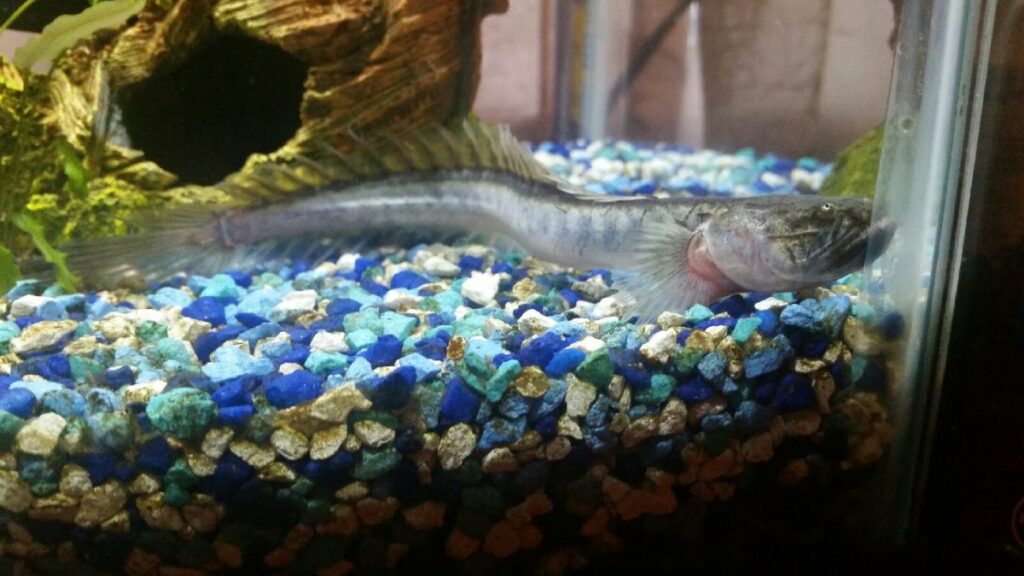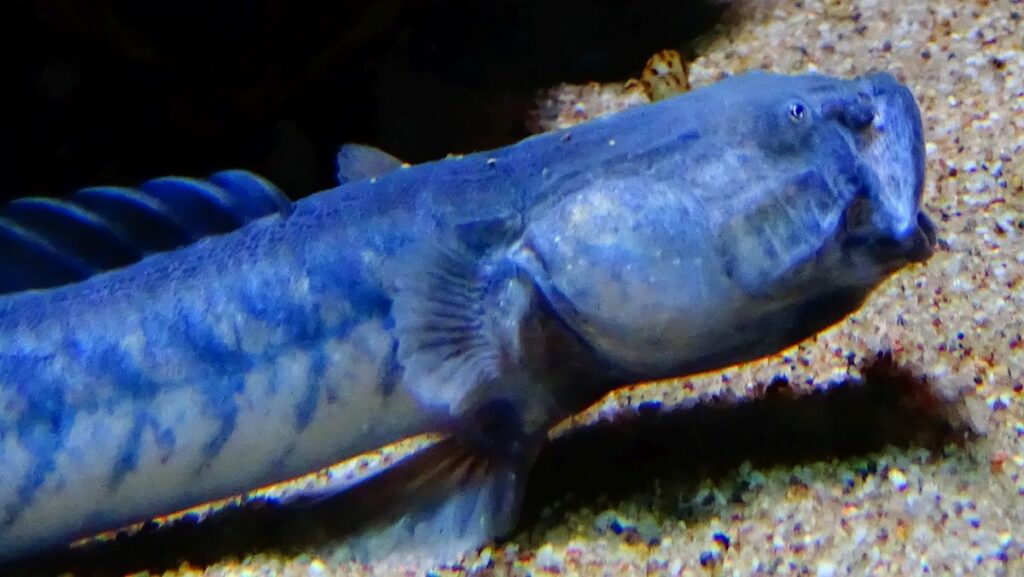The dragon goby is well named, with a row of spiny dorsal fins and flaring pectoral fins. They are also known as violet dragon fish or violet gobies due to their purple iridescence. Like most true gobies they have fused pelvic fins modified into suction cups. They will cling to stones and even the sides of your tank when not swimming around.

Dragon gobies are pretty rare but not impossible to find in pet stores. They are native to the Atlantic Ocean and brackish estuaries (where a river flows into the sea). In the wild dragon gobies are found from South Carolina in the USA all the way down to northern Brazil.
Dragonfish eels are hardy if you’re prepared for their unusual care requirements. But most of them die because they are sold to hobbyists who aren’t aware of their true needs. Well cared for violet gobies live for up to a decade in captivity.
- Common Names: Dragon Goby, Violet Goby, Dragon Fish
- Scientific Name: Gobioides brousonnetti
- Origin: Atlantic Coast of North & South America
- Length: 15+ inches
- Aquarium Size: 40+ gallons
- Lifespan: Up to 10 years
- Temperament: Peaceful
- Ease of Care: Moderate
Dragon Fish Goby Habitat and Aquarium Setup
The keys to success in dragon goby care are providing the right substrate and saline water conditions. As estuarine fish they prefer a fine grained substrate of sand, silt, or even mud. Since mud isn’t appropriate for most aquariums, use fine sand.
Dragon gobies sift through the sand looking for hidden morsels of food. They also spend a lot of time buried under the sand with just their eyes showing. Your sand substrate should be at least 3 inches deep, with more being better.
Don’t keep a dragon goby eel in an aquarium with gravel. The sharp grains will scratch their scaleless skin as they try to dig. These scrapes may become infected over time.
Fish with small scales or no scales are hard to treat with medications. They absorb more of the formula than the dosing instructions intend. You might end up killing a dragon goby with an antibiotic or anti parasite formula. Prevention is the best medicine, in this case.
Their love of digging and large adult size means that you should not keep dragon gobies with live plants. Live plants will be uprooted, soon killing them.
Java fern is a good plant for a dragon fish tank, however. Unlike most freshwater aquarium plants it is tolerant of brackish water. Java fern is also an epiphyte so it won’t get uprooted. These ferns grow attached to hard surfaces like rocks instead of rooted in the sand.
The aquarium aquascape should have lots of open floor space along the bottom. Dragon gobies are long bottom dwelling fish so don’t crowd the area with too many rocks or driftwood pieces.
Freshwater Dragon Eel Water Conditions
Even if you provide a deep sand substrate, your dragon goby will die without salt in their water. These are a brackish and marine fish species. Violet dragon fish will swim into full freshwater for a few days or weeks at a time, looking for new feeding areas. But they must return to brackish or saltwater.
In pet stores these “freshwater” dragonfish will stay alive long enough for someone to buy them. But they won’t live for more than a few months without salt.
Salt levels need to be, at a minimum, ¼ that of full seawater. When performing a water change or filling a new aquarium, mix a quarter of the volume by following the instructions on a package of aquarium sea salt. And use regular, dechlorinated tap water for the rest of the addition.
Water temperatures of 70-80℉ are ideal for them. The water chemistry should be moderate to alkaline, with a pH of 6.5-8.0. Medium to high levels of dissolved minerals are preferable.
What Do Dragon Gobies Eat?

Another reason why dragon gobies are a difficult fish is that their feeding requirements aren’t well understood. They are wild caught and take time to transition over to flakes and pellets. Violet gobies also eat slower than other fish. They get outcompeted in an aquarium full of fast moving tank mates and could starve to death.
Dragon eel fish feed on detritus along the estuary bottom. Algae, flakes, soft pellets, brine shrimp, and tubifex worms are typical food for them.
Dried nori strips pre soaked in water and clipped near the bottom of the tank are a good introductory food. If your dragon fish don’t actively feed, try directing a bit of food towards them using thawed frozen food and a turkey baster.
Dragon Goby Tank Mates
Dragonfish eels look vicious or even predatory. But they are a peaceful species, with few teeth and dim vision. Small tank mates like shrimp or guppies may be eaten but that’s opportunistic feeding, not aggression.
Any brackish water fish that is not aggressive will make a good dragon goby tank mate. Molly fish are a popular choice since they need salt as much as these gobies do.
Scats (Scatophagus sp.) are brackish water omnivores that eat anything, including feces they come across. Scats grow large and fast, however. So be prepared to provide them with at least 90 gallons of space.
Silver monos (also known as moonyfish or diamondfish) are rarer brackish water pets. These are schooling fish that look like marine butterflyfish. Monos also get big, up to 10 inches long.
Most freshwater pufferfish (except for the pea puffer and mbu puffer) prefer brackish water conditions. They are aggressive, however, and in a small aquarium may start to pick at their tank mates.
Other good brackish tank mates include archerfish, Colombian shark catfish, and orange chromide cichlids.
Breeding Dragon Violet Gobies
The successful breeding of goby dragon fish has not been recorded in captivity so far. The two sexes have few visual differences. Both are a pale purple in color and similar in size. One way to tell is by examining their genital organs.
When extended, the male has a pointed organ while the female’s is rounder. But you’ll need to have both sexes on hand for comparison. That isn’t easy to do because dragon gobies are territorial towards one another. Unless your tank is very large (75+ gallons) you’ll not be able to keep more than one dragon goby eel.
Conclusion
The dragon goby eel is an impressive looking aquarium fish that isn’t so fierce. They aren’t difficult to keep if you’re prepared to provide a sand bottomed brackish water tank with the right food. Violet gobies are long lived and peaceful bottom dwellers that are a staple for the brackish side of the hobby.
FAQs
Dragon gobies grow up to 2 feet long in the wild. In captivity they are sold around 5 to 8 inches long. You should expect your violet goby to reach at least 15 inches in captivity.
Dragon gobies are opportunistic predators. Small, slow moving or unwary fish like guppies may be eaten. But they prefer small invertebrates and algae for food.
Dragon gobies will eat shrimp. They should not be kept alongside ornamental species. If your tank has breeding ghost shrimp the young will make good supplemental food for them, however.

